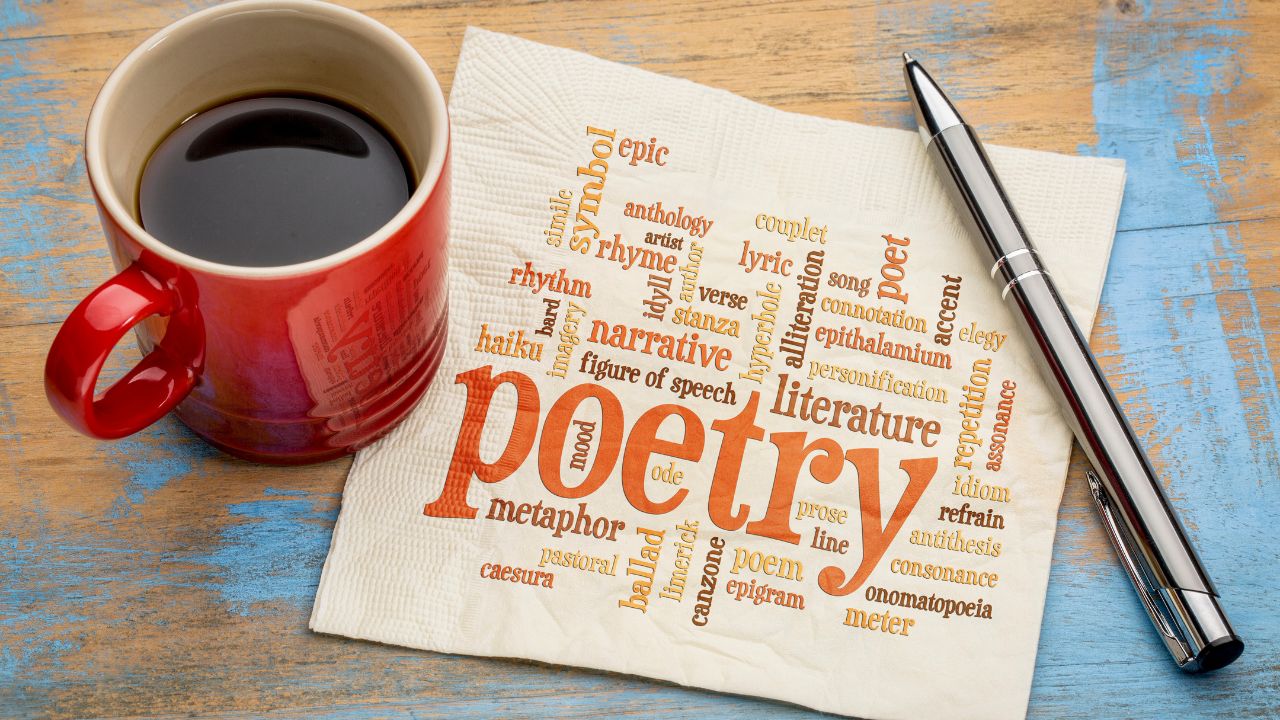- Understanding Poetry
- The Essence of Poetry
- Understanding the Language of Poetry
- Poetry Styles and Forms
- Reading and Interpreting Poetry
- Is Poetry A Dying Art Form?
- Why Should We Still Read Poetry in the 21st century?
- Writing Your Own Poetry
- Conclusion
- Keywords
- Key Takeaways
- You Might Still Be Wondering about…
- How does the use of literary devices enhance the impact of a poem?
- Can poetry be fully understood and appreciated without considering the poet’s intended meaning?
- How does the structure of a poem, such as its rhyme scheme or syllable pattern, contribute to its overall effect?
- How can poetry address social and cultural issues effectively?
- What role does personal experience play in the creation of poetry?
- How does poetry differ from other forms of written expression, such as prose or essays?
- Are there any universal themes or subjects that poetry frequently explores across cultures?
- How does reading poetry aloud enhance the understanding and appreciation of the poem?
- Can a poem be successful without adhering to traditional poetic forms or structures?
- How can poetry be relevant in the modern digital age?
- Common Misconceptions
Understanding Poetry
The world of literature is diverse and endless. One of its most powerful and captivating branches is poetry, an art form that has been utilized by humanity to express emotion, thoughts, ideas, and stories for centuries. Poetry is a linguistic painting, a canvas adorned with words and metaphors that create vivid imagery, provoke thought, and stir feelings.
Poetry is unique in its diversity; it encompasses a variety of styles, forms, and techniques. Some poems adhere strictly to rules of rhythm and rhyme, while others opt for a more freeform approach. This variety ensures that there is something for everyone in the realm of poetry, regardless of personal tastes or preferences. This guide serves as a beginner’s guide to the world of poetry, introducing its basics, styles, and ways of understanding and creating poems.
The Essence of Poetry
A poem is a form of artistic expression that conveys the poet’s thoughts or emotions in a concentrated, imaginative, and rhythmic manner. Poetry’s core essence is in its ability to use language and form to evoke emotion, convey complex concepts, and paint vivid mental pictures. Poems can be about anything – love, loss, joy, sorrow, the human condition, social issues, or even abstract concepts like time and existence.
The power of a poem often lies not just in what is said, but how it is said. Poets use a range of literary techniques, such as metaphor, simile, alliteration, and onomatopoeia, to bring their words to life. These techniques, combined with the careful selection and arrangement of words, give poems their unique ability to express the ineffable and stir the reader’s soul.
Understanding the Language of Poetry
To truly appreciate poetry, it’s important to familiarize oneself with the language and literary devices poets use. A key aspect of this language is ‘imagery’ – the use of vivid, descriptive language to create mental images. Imagery is often achieved through metaphor and simile. A metaphor is a direct comparison, such as ‘Life is a rollercoaster’, while a simile is an indirect comparison using ‘like’ or ‘as’, for instance, ‘She is as graceful as a swan’.
Another important device is ‘alliteration’ – the repetition of consonant sounds at the beginning of words, which can create a rhythmic or musical effect. An example would be ‘Peter Piper picked a peck of pickled peppers’. There’s also ‘assonance’, the repetition of vowel sounds, and ‘consonance’, the repetition of consonant sounds within or at the ends of words.
‘Onomatopoeia’, the use of words that sound like what they represent (like ‘buzz’ or ‘hiss’), and ‘personification’, attributing human qualities to non-human things or abstract ideas, are also key tools in a poet’s kit.
Poetry Styles and Forms
Poetry comes in many forms, each with its unique characteristics. Here are some of the most well-known:
- Sonnet: Originating from Italy, sonnets consist of 14 lines and have a specific rhyme scheme. The Shakespearean sonnet, named after its most famous practitioner, is one of the most recognized forms in English literature.
- Haiku: This Japanese form of poetry is composed of three lines with a 5-7-5 syllable pattern. Haikus often depict nature or seasons and are known for their simplicity and depth.
- Limerick: Limericks are humorous or nonsensical poems of five lines, with a distinct rhythm and a rhyme scheme of AABBA.
- Free Verse: Unlike other forms, free verse does not adhere to any set rhythm or rhyme scheme, offering poets more freedom in their creative expression.
- Epic: Epics are long, narrative poems that tell heroic stories. Classic examples include Homer’s ‘The Iliad’ and ‘The Odyssey’.
- Lyric: Lyric poems, often used in songs, express personal emotions or thoughts. They are known for their musicality and are usually shorter than other forms.
Reading and Interpreting Poetry
When reading a poem, it’s essential to not rush through but take your time to absorb each line and image. Remember, poetry is as much about how it’s said as what is said. The rhythm, the sounds of the words, the way they’re arranged on the page – all these elements contribute to the poem’s overall effect.
Interpreting a poem can be a deeply personal experience, as different readers might connect with different aspects of the poem. It’s about finding meaning within the lines that resonates with you. While understanding the poet’s intended meaning can enhance your appreciation, poetry is subjective, and there’s no ‘right’ or ‘wrong’ interpretation.
Is Poetry A Dying Art Form?
Whether poetry is a dying art or not is a matter of perspective and context. Some argue that traditional forms of poetry are less popular today than they once were, but it’s crucial to recognize that the nature of poetry is evolving rather than dying.
Poetry today often takes new forms, influenced by contemporary societal changes and technological advancements. For example, the advent of social media has given rise to platforms like Instagram and Twitter, where ‘instapoetry’ or ‘micropoetry’ have become popular. These platforms allow poets to reach global audiences instantly, something that was not possible in earlier times. Poets such as Rupi Kaur have gained massive audiences through these mediums.
Moreover, the rise of spoken word and slam poetry, often performed in live or virtual events and shared via video sharing platforms like YouTube, has also introduced poetry to new demographics, making it more interactive and accessible.
Additionally, the themes and styles of poetry continue to evolve, reflecting current societal issues and individual experiences. This adaptation to modern contexts and audiences indicates that poetry is not a dying art but one that continues to reinvent itself.
It’s also worth noting that poetry’s function as a powerful medium for expressing personal emotions, societal commentary, and cultural experiences remains unchanged. Therefore, as long as there are people willing to explore their experiences and ideas through verse, poetry will continue to exist.
In the academic sphere, poetry is also very much alive. It’s studied in schools, colleges, and universities worldwide, introducing new generations to both classical and contemporary poetry.
So, while the popularity of different forms of poetry may rise and fall, it’s more accurate to say that the art of poetry is evolving rather than dying.
Why Should We Still Read Poetry in the 21st century?
Reading poetry in the 21st century remains valuable for several reasons:
- Emotional Resonance: Poetry allows us to connect deeply with our emotions and experiences. It can offer solace, joy, and understanding, acting as a form of emotional catharsis.
- Expands Thought and Imagination: Poetry often uses rich imagery, metaphor, and symbolic language, which can stimulate the imagination and encourage us to think in non-linear and creative ways.
- Cultural and Historical Perspective: Poetry serves as a cultural and historical record, reflecting the values, struggles, and experiences of different times and places. Reading poetry helps us understand different perspectives and promotes empathy and cultural sensitivity.
- Language Appreciation: Poetry’s focus on rhythm, sound, and word choice can foster a deeper appreciation for language. It’s a great way to expand vocabulary, understand the nuanced meanings of words, and explore the possibilities of language.
- Conveys Universal Themes and Experiences: Many themes explored in poetry—such as love, loss, change, and identity—are universal. Reading poetry can offer insights into shared human experiences, fostering a sense of connection and understanding.
- Mindful Reading: The compact nature of poetry requires careful reading and often, re-reading. This promotes mindfulness, patience, and attention to detail, which can be a meditative and stress-reducing activity.
- Critical Thinking: Interpreting poetry often involves unpacking multiple layers of meaning, which can develop critical and analytical thinking skills.
- Innovation in Digital Space: Contemporary poetry has embraced the digital space, often blurring the lines between written word, performance, and visual art. Engaging with this innovative form of expression can offer a fresh perspective and understanding of the current cultural landscape.
So, despite the changes in the literary landscape, poetry continues to be an essential and enriching part of human culture and individual personal development.
Writing Your Own Poetry
Writing poetry is a wonderful way to express your thoughts, feelings, and experiences. Begin by reading widely to expose yourself to different styles and forms. When you’re ready to write, choose a topic you feel strongly about. Use vivid imagery and descriptive language to express your ideas. Don’t worry about getting it ‘right’ the first time. Writing is a process of revision and refinement.
Remember, there are no hard and fast rules in poetry. Some of the greatest poems break all conventions and create their own. The most important thing is to write from the heart and not be afraid to express yourself authentically.
Conclusion
Poetry is a rich, beautiful, and diverse art form that has the power to inspire, provoke thought, and express the depths of human emotion. As you embark on your poetic journey, remember that the beauty of poetry lies in its subjectivity. There’s a poem for every person, a poem for every mood, and a poem for every moment. Embrace the world of poetry, and it will enrich your life in ways you never expected.
Whether you’re a reader, a writer, or both, poetry offers a unique avenue to explore the human experience. So take a deep breath, open a book of poems, or pick up a pen and start writing. Welcome to the world of poetry – your adventure is just beginning.
Keywords
- Poetry: A form of artistic expression that uses language and form to convey thoughts, emotions, and ideas in a concentrated, imaginative, and rhythmic manner.
- Art form: A medium or genre of artistic expression that is characterized by its specific techniques, styles, and forms.
- Imagery: The use of vivid, descriptive language in poetry to create mental images and appeal to the senses.
- Metaphor: A figure of speech that directly compares two unrelated things or ideas, suggesting a similarity between them.
- Simile: A figure of speech that indirectly compares two things or ideas using “like” or “as” to establish a resemblance.
- Alliteration: The repetition of consonant sounds at the beginning of words in close proximity to create a rhythmic or musical effect.
- Assonance: The repetition of vowel sounds within words to create a similar or rhyming effect.
- Consonance: The repetition of consonant sounds within or at the ends of words for a harmonious or musical effect.
- Onomatopoeia: The use of words that imitate or resemble the sounds associated with the objects or actions they refer to.
- Personification: The attribution of human qualities or characteristics to non-human things or abstract concepts.
Key Takeaways
- Poetry is a diverse art form that uses language and form to convey emotions, thoughts, and ideas.
- Poems can cover a wide range of subjects, including love, loss, social issues, and abstract concepts.
- Poets use various literary techniques like metaphor, simile, alliteration, and personification to bring their words to life.
- Different styles and forms of poetry, such as sonnets, haikus, limericks, free verse, epics, and lyrics, offer unique characteristics and structures.
- Reading and interpreting poetry require attentiveness to rhythm, sounds, and arrangement of words, while allowing for personal interpretation.
- Writing poetry is a creative process that involves using descriptive language, vivid imagery, and personal expression.
- There are no strict rules in poetry, and breaking conventions can lead to innovative and powerful poetic creations.
You Might Still Be Wondering about…
How does the use of literary devices enhance the impact of a poem?
Literary devices like metaphor, simile, alliteration, and personification help create vivid imagery, evoke emotions, and make the poem more memorable and engaging. They add layers of meaning and enrich the overall impact of the poem.
Can poetry be fully understood and appreciated without considering the poet’s intended meaning?
While understanding the poet’s intended meaning can provide valuable insights, poetry is subjective, and different readers may connect with different aspects of the poem. Personal interpretation plays a significant role in appreciating and finding meaning in poetry.
How does the structure of a poem, such as its rhyme scheme or syllable pattern, contribute to its overall effect?
The structure of a poem influences its rhythm, musicality, and flow. Rhyme schemes and syllable patterns create a sense of order or musicality, while variations in structure can convey emotions, emphasize certain words, or create surprises for the reader.
How can poetry address social and cultural issues effectively?
Poetry has the power to shed light on social and cultural issues by conveying emotions and experiences that resonate with readers. By using vivid imagery, metaphors, and powerful language, poets can evoke empathy, challenge norms, and inspire action or reflection.
What role does personal experience play in the creation of poetry?
Personal experiences often serve as a rich source of inspiration for poets. Drawing from their own emotions, memories, and observations, poets can infuse their work with authenticity and create a deep connection with the readers.
How does poetry differ from other forms of written expression, such as prose or essays?
Poetry distinguishes itself through its focus on condensed and concentrated language, the use of literary devices, and the emphasis on rhythm and imagery. Unlike prose or essays, poetry often aims to evoke emotions and create a sensory experience through its artistic language and form.
Are there any universal themes or subjects that poetry frequently explores across cultures?
While the specific themes and subjects of poetry vary across cultures, certain universal themes emerge, such as love, nature, death, longing, and the human condition. These themes resonate with people from different cultural backgrounds and have been explored throughout literary history.
How does reading poetry aloud enhance the understanding and appreciation of the poem?
Reading poetry aloud allows the reader to experience the rhythm, sounds, and musicality of the language. It helps in capturing the intended cadence, emphasizes the poet’s use of literary devices, and brings the words to life in a way that silent reading may not fully achieve.
Can a poem be successful without adhering to traditional poetic forms or structures?
Yes, a poem can be successful without adhering to traditional forms or structures. Free verse and experimental poetry, for example, allow for creative freedom and innovation. The effectiveness of a poem lies in its ability to evoke emotions, convey meaning, and engage the reader, regardless of its form or structure.
How can poetry be relevant in the modern digital age?
The digital age offers new platforms and mediums for sharing and experiencing poetry, such as social media, online publications, and spoken word performances. Poetry continues to be relevant by addressing contemporary issues, expressing diverse voices, and connecting people through shared emotions and experiences.
Common Misconceptions
Misconception: Poetry is only for intellectuals or academics.
Reality: Poetry is accessible to everyone, regardless of their educational background. It can be enjoyed, appreciated, and created by people from all walks of life.
Misconception: Poetry must always rhyme.
Reality: While some poems utilize rhyme, many contemporary poems and certain forms, like free verse, do not require rhyme. Rhyme is a poetic tool, but it is not a defining characteristic of all poetry.
Misconception: There is a single correct interpretation of a poem.
Reality: Poetry allows for multiple interpretations, and different readers may find different meanings within the same poem. Personal experiences and perspectives shape how individuals understand and relate to a poem.
Misconception: Writing poetry requires strict adherence to rules and conventions.
Reality: While poetry can follow established forms and techniques, there are no rigid rules. Poets have the freedom to experiment, break conventions, and create their own unique styles and structures.
Misconception: Poetry is always serious and difficult to understand.
Reality: Poetry encompasses a wide range of tones and subjects, including humor, joy, and everyday experiences. While some poems may be complex, there are also accessible and relatable poems that resonate with diverse audiences.
Misconception: Poetry is irrelevant in the modern world.
Reality: Poetry continues to thrive and evolve, adapting to contemporary contexts and addressing current issues. It provides a space for personal expression, reflection, and connection, making it relevant to individuals and communities.
Misconception: Only professional poets can write poetry.
Reality: Anyone can write poetry as a form of personal expression, regardless of their professional background. Writing poetry is open to all individuals who have the desire to explore their thoughts and emotions through words.
Misconception: Poetry is outdated and belongs to the past.
Reality: While poetry has a rich history, it remains a vibrant and living art form. Modern poets continue to push boundaries, explore new themes, and engage with current social and cultural contexts.
Misconception: Poetry is purely subjective and lacks meaning.
Reality: While poetry allows for personal interpretation, it is not devoid of meaning. Poets often craft their work with specific intentions, and poems can convey profound insights, emotions, and social commentary.
Misconception: Poetry is only for those who are skilled in writing or literature.
Reality: Poetry can be enjoyed and appreciated by anyone, regardless of their writing or literary expertise. The emotional impact and personal resonance of a poem can be experienced by readers of diverse backgrounds and interests.










0 Comments